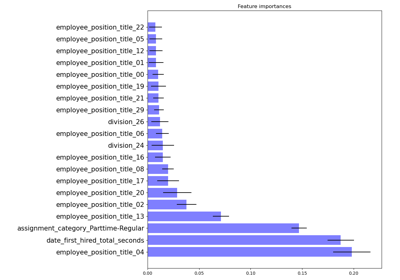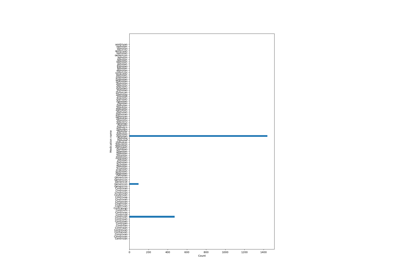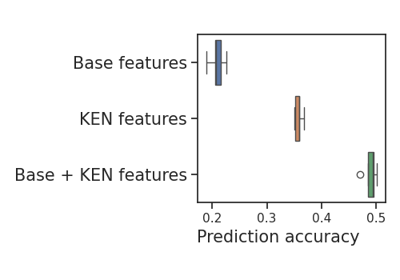skrub.MinHashEncoder#
Usage examples at the bottom of this page.
- class skrub.MinHashEncoder(*, n_components=30, ngram_range=(2, 4), hashing='fast', minmax_hash=False, n_jobs=None)[source]#
Encode string categorical features by applying the MinHash method to n-gram decompositions of strings.
Note
MinHashEncoderis a type of single-column transformer. Unlike most scikit-learn estimators, itsfit,transformandfit_transformmethods expect a single column (a pandas or polars Series) rather than a full dataframe. To apply this transformer to one or more columns in a dataframe, use it as a parameter in askrub.TableVectorizerorsklearn.compose.ColumnTransformer. In theColumnTransformer, pass a single column:make_column_transformer((MinHashEncoder(), 'col_name_1'), (MinHashEncoder(), 'col_name_2'))instead ofmake_column_transformer((MinHashEncoder(), ['col_name_1', 'col_name_2'])).The principle is as follows:
A string is viewed as a succession of numbers (the ASCII or UTF8 representation of its elements).
The string is then decomposed into a set of n-grams, i.e. n-dimensional vectors of integers.
A hashing function is used to assign an integer to each n-gram. The minimum of the hashes over all n-grams is used in the encoding.
This process is repeated with N hashing functions to form N-dimensional encodings.
Maxhash encodings can be computed similarly by taking the maximum hash instead. With this procedure, strings that share many n-grams have a greater probability of having the same encoding value. These encodings thus capture morphological similarities between strings.
- Parameters:
- n_components
int, default=30 The number of dimension of encoded strings. Numbers around 300 tend to lead to good prediction performance, but with more computational cost.
- ngram_range2-tuple of
int, default=(2, 4) The lower and upper boundaries of the range of n-values for different n-grams used in the string similarity. All values of n such that
min_n <= n <= max_nwill be used.- hashing{‘fast’, ‘murmur’}, default=’fast’
Hashing function. fast is faster than murmur but might have some concern with its entropy.
- minmax_hash
bool, default=False If True, returns the min and max hashes concatenated.
- n_jobs
int, optional The number of jobs to run in parallel. The hash computations for all unique elements are parallelized. None means 1 unless in a joblib.parallel_backend. -1 means using all processors. See n_jobs for more details.
- n_components
See also
GapEncoderEncodes dirty categories (strings) by constructing latent topics with continuous encoding.
SimilarityEncoderEncode string columns as a numeric array with n-gram string similarity.
deduplicateDeduplicate data by hierarchically clustering similar strings.
References
For a detailed description of the method, see Encoding high-cardinality string categorical variables by Cerda, Varoquaux (2019).
Examples
>>> import pandas as pd >>> from skrub import MinHashEncoder >>> enc = MinHashEncoder(n_components=5)
Let’s encode the following non-normalized data:
>>> X = pd.Series(['paris, FR', 'Paris', 'London, UK', 'London'], name='city') >>> enc.fit(X) MinHashEncoder(n_components=5)
The encoded data with 5 components are:
>>> enc.transform(X) city_0 city_1 city_2 city_3 city_4 0 -1.783375e+09 -1.588270e+09 -1.663592e+09 -1.819887e+09 -1.962594e+09 1 -8.480470e+08 -1.766579e+09 -1.558912e+09 -1.485745e+09 -1.687299e+09 2 -1.975829e+09 -2.095000e+09 -1.596521e+09 -1.817594e+09 -2.095693e+09 3 -1.975829e+09 -2.095000e+09 -1.530721e+09 -1.459183e+09 -1.580988e+09
- Attributes:
Methods
fit(X[, y])Fit the MinHashEncoder to X.
fit_transform(X[, y])Fit to data, then transform it.
Get output feature names for transformation.
Get metadata routing of this object.
get_params([deep])Get parameters for this estimator.
set_fit_request(*[, column])Request metadata passed to the
fitmethod.set_output(*[, transform])Set output container.
set_params(**params)Set the parameters of this estimator.
transform(X)Transform X using specified encoding scheme.
- fit(X, y=None)[source]#
Fit the MinHashEncoder to X.
In practice, just initializes a dictionary to store encodings to speed up computation.
- Parameters:
- Xarray_like, shape (n_samples, ) or (n_samples, n_columns)
The string data to encode. Only here for compatibility.
- y
None Unused, only here for compatibility.
- Returns:
MinHashEncoderThe fitted MinHashEncoder instance (self).
- fit_transform(X, y=None, **fit_params)[source]#
Fit to data, then transform it.
Fits transformer to X and y with optional parameters fit_params and returns a transformed version of X.
- Parameters:
- Xarray_like of shape (n_samples, n_features)
Input samples.
- yarray_like of shape (n_samples,) or (n_samples, n_outputs), default=None
Target values (None for unsupervised transformations).
- **fit_params
dict Additional fit parameters.
- Returns:
- get_metadata_routing()[source]#
Get metadata routing of this object.
Please check User Guide on how the routing mechanism works.
- Returns:
- routingMetadataRequest
A
MetadataRequestencapsulating routing information.
- set_fit_request(*, column='$UNCHANGED$')[source]#
Request metadata passed to the
fitmethod.Note that this method is only relevant if
enable_metadata_routing=True(seesklearn.set_config()). Please see User Guide on how the routing mechanism works.The options for each parameter are:
True: metadata is requested, and passed tofitif provided. The request is ignored if metadata is not provided.False: metadata is not requested and the meta-estimator will not pass it tofit.None: metadata is not requested, and the meta-estimator will raise an error if the user provides it.str: metadata should be passed to the meta-estimator with this given alias instead of the original name.
The default (
sklearn.utils.metadata_routing.UNCHANGED) retains the existing request. This allows you to change the request for some parameters and not others.Added in version 1.3.
Note
This method is only relevant if this estimator is used as a sub-estimator of a meta-estimator, e.g. used inside a
Pipeline. Otherwise it has no effect.
- set_output(*, transform=None)[source]#
Set output container.
See Introducing the set_output API for an example on how to use the API.
- Parameters:
- transform{“default”, “pandas”, “polars”}, default=None
Configure output of transform and fit_transform.
“default”: Default output format of a transformer
“pandas”: DataFrame output
“polars”: Polars output
None: Transform configuration is unchanged
Added in version 1.4: “polars” option was added.
- Returns:
- selfestimator instance
Estimator instance.
- set_params(**params)[source]#
Set the parameters of this estimator.
The method works on simple estimators as well as on nested objects (such as
Pipeline). The latter have parameters of the form<component>__<parameter>so that it’s possible to update each component of a nested object.- Parameters:
- **params
dict Estimator parameters.
- **params
- Returns:
- selfestimator instance
Estimator instance.
- transform(X)[source]#
Transform X using specified encoding scheme.
- Parameters:
- Xarray_like, shape (n_samples, ) or (n_samples, n_columns)
The string data to encode.
- Returns:
ndarrayof shape (n_samples, n_columns * n_components)Transformed input.
Examples using skrub.MinHashEncoder#

Encoding: from a dataframe to a numerical matrix for machine learning

